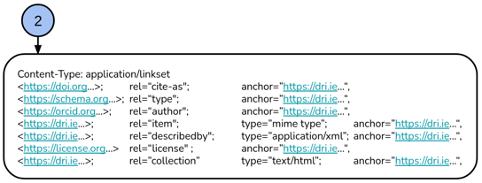Last year the Digital Repository of Ireland was awarded a grant to participate in the FAIR-IMPACT project (project lead: Senior Software Engineer Kathryn Cassidy), which gave us access to the expertise and support we needed to test out several current and emerging FAIR-enabling tools. In this blog, we asked our Junior Software Developer Murilo Dias to share his experience implementing FAIR Signposting for the Repository.
In the dynamic realm of web design, where aesthetics meet functionality, creating an engaging and user-friendly interface is the holy grail. Most of us are familiar with the visual elements that allow us to navigate websites, easily using gadgets like navbars, sliders, buttons, underlined links and video players to find and engage with content. For example, among users of the Repository, it is generally understood that clicking on a link called “Download” will allow them to download an object’s files, while the “breadcrumb trail” navigation links under main menus help them to navigate between Collections, Sub-Collections and the Digital Objects they contain (see picture below). At DRI, we aim to follow best practices in web design and navigation, carrying out user testing to ensure that navigating the Repository is as simple and intuitive as possible.
A machine client accessing the Repository gets a very different view, however. The code underlying any website includes the information necessary to display the website correctly, but the code itself may be messy, with tags often out of place. Cleaning up the ‘behind-the-scenes’ instructions so that a machine client can decipher the meaning or structure of the content as easily as a human can read the visual display is where techniques such as web crawlers, machine learning, sitemaps — and FAIR Signposting — come into play.
FAIR Signposting can bridge the gap between the human-friendly front end and the intricate back end.


WHAT IS FAIR SIGNPOSTING? FAIR Signposting introduces a standardised way for machine agents to navigate scholarly web objects. it’s a game-changer for the scholarly community, offering a structured approach to enhance the findability, accessibility, interoperability, and reusability (FAIRness) of scholarly objects.
The Value Proposition:
- Findable: Make your scholarly objects easily discoverable in the vast digital landscape.
- Accessible: Provide a map for machine agents to seamlessly navigate the scholarly web.
- Interoperable: Embrace widely implemented web protocols for enhanced compatibility.
- Reusable: Facilitate informed navigation, making scholarly objects more reusable than ever.
Levels of Compliance:
There are two levels of compliance, each bringing its own set of advantages.
- Level 1: Provide a minimal set of typed links with the landing page as the link origin.
- Mandatory: Provide links in the landing page’s HTTP Link header or HTML <link> elements.
- Recommended: Extra links for content and metadata in respective HTTP Link headers.
- Level 2: Elevate your compliance by providing a comprehensive set of typed links for landing pages, content, and metadata resources.
- Mandatory: Provide a linkset with links for landing pages, content, and metadata.
- Mandatory: Make it discoverable via headers or <link> elements.Recommended: Extra links for content and metadata in respective HTTP Link headers.
- Recommended: Extra links for content and metadata in respective HTTP Link headers.
Implementation Insights: In our case at DRI, we decided to aim for Level 2 compliance, but the journey can be broken into two steps by achieving Level 1 first and subsequently conquering Level 2. The implementation intricacies vary, demanding a close analysis according to the class hierarchy of the specific application.
HOW DOES IT WORK? Our application, built on Ruby on Rails, employs two controllers to answer requests, leveraging a helper class that provides the necessary methods for gathering essential information. The helper class ensures the validity of requests, checking user access requirements and object ID validity, and responding appropriately with either the requested data or a courteous refusal.



| Field | Relation | Description |
| Cite-as | One or zero | Persistent Identifier (doi.org) |
| Landing page | One | Archive page (dri.ie) |
| Type | One or two | Mandatory: schema.org/AboutPage Optional: schema/org/<file type> |
| Author | Zero, one or many | Author link (orcid.org) |
| Item | One or many | Asset (file) download link |
| Described by | One | Metadata link |
| License | One or zero | Licence if available |
| Collection | One | Link to DRI collection (dri.ie) |
WHAT’S THE RESULT? We are very pleased to share that DRI has successfully implemented FAIR Signposting Level 2 in the Repository. Anecdotally, we are also happy to note a significant improvement in the FAIRness score of several sample datasets which were assessed using the F-UJI tool for automated FAIR data assessment. This tool was developed primarily to give research services and repositories feedback on how easily machines could perform actions associated with the FAIR principles, using the FAIRsFAIR Data Object Assessment Metrics.

FAIRness Improvement:
One sample dataset improved from 37% to 54% FAIR, with key improvements in 3 of the 4 areas of assessment. This is a great indication of better machine actionability for datasets in the Repository, showcasing the positive impact of this standardised approach.
It’s worth noting here that the FAIR principles are designed to support both human and machine interpretability, with F-UJI primarily assessing the latter only. As part of DRI’s ongoing work in other research projects like WorldFAIR, we aim to give feedback on how tools like F-UJI can offer a more nuanced assessment of FAIR compliance with disciplinary standards and methods.
CONCLUSION FAIR Signposting is not just a technical enhancement; it’s a transformative approach to scholarly web navigation. As we embrace this standardised method, institutions can choose their compliance journey, tailoring it to their specific needs. In the intricate dance between human interaction and machine readability, FAIR Signposting emerges as the guiding light, ensuring a seamless and enriching scholarly web experience.
References / Useful links:



